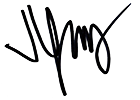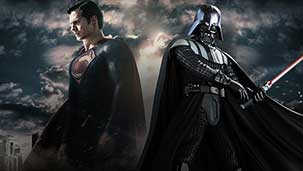Dear Readers,
Two movie trailers set the internet ablaze last week. At the annual Star Wars Celebration festival in Anaheim, director J.J. Abrams debuted the second The Force Awakens trailer to an auditorium full of eager fans. Earlier that same afternoon, in what you might call a teaser for the teaser of the trailer, Zack Snyder offered a few quick (and rather feckless) clips from Batman v Superman: Dawn of Justice.
All this pageantry and playing coy is considered best practice for film marketers; trailer releases have become almost as important as the actual release of the film—and probably more important to those opening weekend numbers than the actual quality of the film. But these two particular trailers –in the aesthetics they purport to represent and the manner in which they were debuted – are indicative of two very different attitudes towards the contemporary Hollywood blockbuster. One approach has exhausted critics, seems to be on the brink of exhausting fans, and may soon exhaust its momentum at the box office. The other approach, rooted in the not-so-distant past, might revive the diminishing artistic returns of the major studios’ tent-pole popcorn flicks.
But first, the two trailers:
The Force Awakens bets heavily on nostalgia: we begin with a panoramic view of a familiar desert planetscape (not Tattooine, but a new arid, windswept world); we get X-Wings and tie fighters; and, most notably, a Luke Skywalker voice-over and our first glimpse of retirement-age Han Solo. If you’re not a Star Wars devotee (and no mystical energy field controls your destiny), much of this won’t matter to you. But if you are a fan, the swell of John Williams’ melodic strings and winds likely dried your throat, and the glimpses of your old pals Artoo and Chewie may have brought tears to your eyes.
Batman v Superman is a much different trailer. After Snyder’s flirtatious tweets, it “leaked” a week early (who can say whether the marketing team at Warner Bros. is just incompetent, or so incompetent that they’re brilliant). It begins with the standard throb of ominous ambient noise, then gives us a little Charlie Rose voice-over (which isn’t quite as affecting as hearing Mark Hamill); then a slow tracking shot towards a shadowed statue that is revealed to be, yes, a monument to Superman with, yes, graffiti scrawled across the chest that reads: False God.
Zack Snyder has never been one for subtlety. Whatever hope there had been that the influence of Christopher Nolan (who produced Man Of Steel, as well as this quasi-sequel) might quell his instinct for misanthropic self-seriousness was crushed by the arrival of his misanthropic, self-serious Superman film. The Dawn of Justice trailer suggests that his follow-up is exactly what you might expect from the much-maligned pop-artist: beautiful, hyper-real CGI shots that seem like moving Rubens paintings, and laughable, hyper-dramatic dialogue (“this is how it starts...the fear, the rage...the feeling of powerlessness...”). This sneak peek at this latest superhero crossover – with which DC Comics and Warner Bros. is hoping to establish an Avengers-style cinematic continuity – is more of the same: lots of shadows, sneering, heavy weaponry and political metaphors so broad that not even the Last Son of Krypton could leap them in a single bound. But let’s be frank: more of the same isn’t a bad thing for the bottom line. Despite being a critical disappointment, Superman’s big screen comeback grossed $668 Million worldwide.
Zack Snyder may not be seeking redemption (he’s admirably unapologetic), and neither is J.J. Abrams (though some people think he should be). But Abrams faces a different challenge with his new flick—perhaps no filmmakers in the history of filmmaking has ever faced higher expectations than Abrams does as the heir to the Holy Trilogy. Online reaction to the very first SW:FA teaser is proof. A pitch perfect capsule of images and sounds that elicited every good feeling about the original trilogy that the prequels supposedly forgot, and still the naysayers found something to complain about.
So what does this new SW:FA trailer suggest about Abrams’ approach? And how does it differ, in its foundational approach to big-budget cinema, from the BvS trailer?
First, it’s important to understand why it makes sense to compare these two pictures. What makes them relative variables is the simple fact that they exist. As recently as a decade ago, the notion of a big-budget superhero film featuring both of DC Comics’ two most iconic characters (along with Wonder Woman and Aquaman, who are featured in a series of promotional posters, and therefore, one supposes, appear in the film—once again WB’s genius/incompetent marketing at work) would have been preposterous. Likewise, the possibility of new Star Wars films – featuring the original cast, no less! – seemed utterly implausible even just a few short years ago. George Lucas’s prequels had seemed to annihilate the franchise’s big screen ambitions (animated properties like Clone Wars and Rebels have thrived on television and in toy aisles). That these two films are being released within a few months of each other suggests that we are reaching the crest of the sea change that began when Marvel began intermingling its characters and bundling them into blockbuster franchises. The narrative continuity that is so important to sci-fi and comic book superfans now exists in theaters. What seemed impossible is now possible. More than possible, actually. Profitable.
So what about Abrams? He’s already rebooted one beloved sci-fi franchise, and, while he didn’t always get the ratio of fan service to storytelling right (says one of the fans he serviced), he resurrected the Enterprise and its crew fairly well. Star Wars will require a defter touch, though, and if this latest trailer is any indication, Abrams may have gotten it right. And he gets it right in direct opposition to the approach Snyder takes. Optimism, positivity, clarity and, most significantly–– a palpable sense of fun something that Hollywood seems to have completely forgotten when it comes to these types of films. What made Abrams’ second Star Trek flick such a disappointment was how much it felt like every other recent mega-action film: incomprehensible action, overwhelming effects, the sound and fury signifying nothing, and, worst of all, an obscenely high body count paired with imagery suggestive (almost offensively) of 9/11.
(You might say he Zack Snyder-ed it.)
But all of this is speculation (and no small amount of barely-suppressed fanboy hope), which is precisely what trailers of this kind are meant to provoke. Maybe The Force Awakens will be dark and gloomy and replete with the kind of slick CGI that contradicts the gritty Old-West aesthetic of the very first film. Maybe Batman v Superman will embrace the absurdity of a superpowered alien fighting a rich old white guy with an underground armory and a taste for cosplay.
But the trailers don’t suggest so. And while these little two-minute commercials the marketing department cuts together are rarely indicative of the quality of the film, they tend to pretty accurately predict a film’s mood and tenor.
There’s little doubt that The Force Awakens will top the list of 2015’s biggest films (and with a Christmas release, might just end up being 2016’s box office champion, too). And there’s also little doubt that Abrams has made it a priority to recapture a bit of the innocence and wonder that made Lucas’ space adventures more than just films. The question is, will this return to a simpler, lighter, more positive approach to the blockbuster reverse the trend that started a decade ago with the Nolan’s first Batman film? Has the gritty reboot run its course? And is that necessarily a good thing?
Good or not, it will be, in the meantime, a relief.
Sincerely,

Jared






